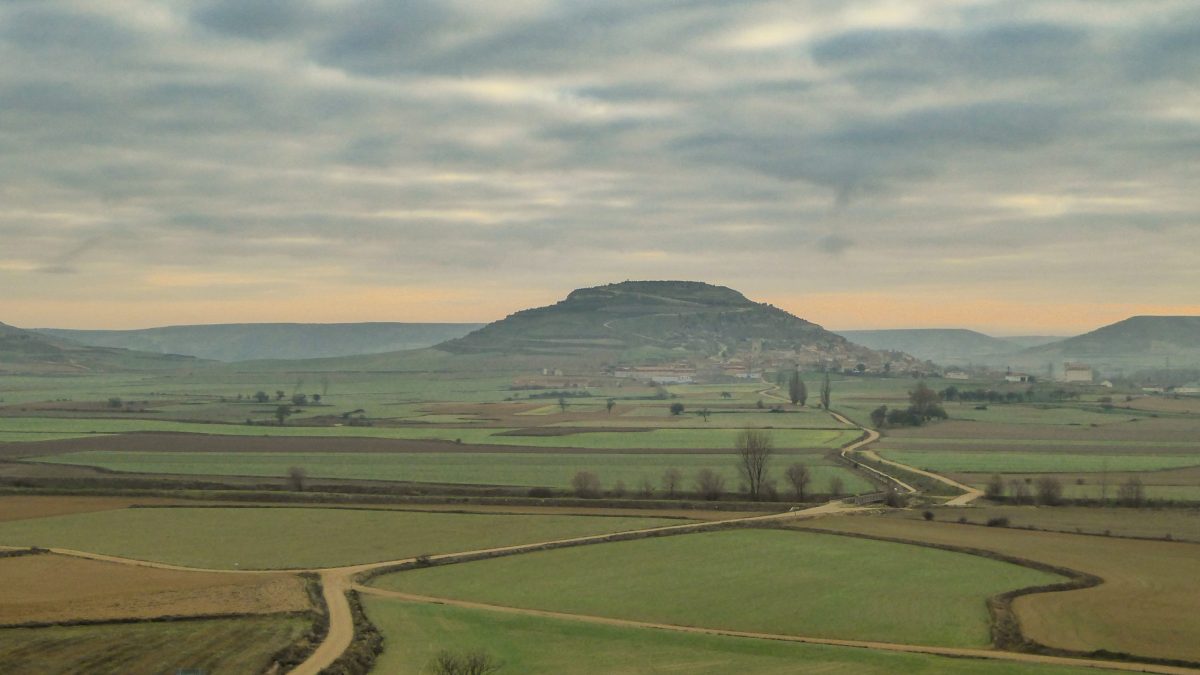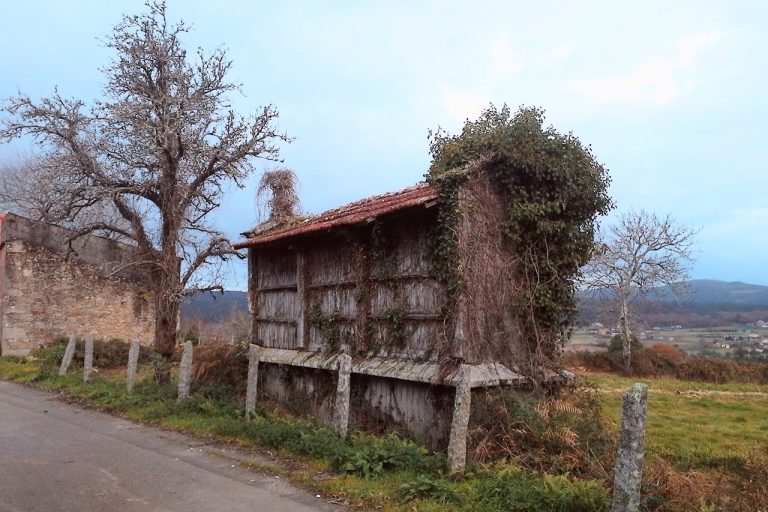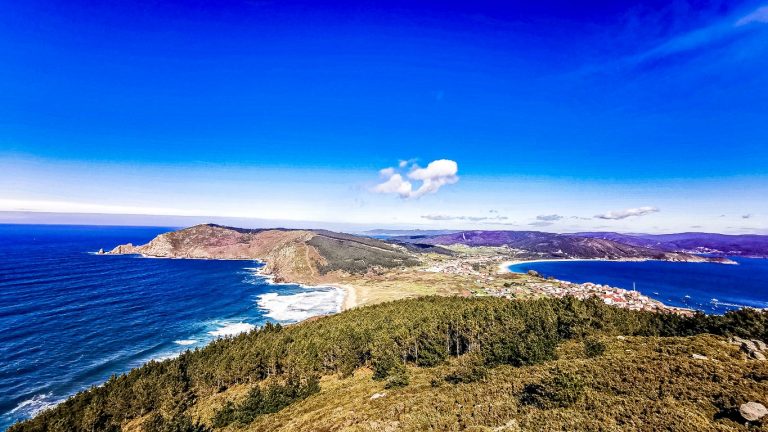
A new stage day – Beginning & mood
The morning in Hornillos del Camino begins in simplicity. A blink of pilgrims’ eyes, muffled footsteps along the quiet village street, the red rooftops glowing in the morning sun. From here the Camino releases you once again into the endless expanse of the Meseta, yet today with the promise that this vastness will not bring you only emptiness, but connection – with the earth, the wind, your own step.
Leaving the village behind, you soon find yourself alone on a gravel track. No shadow, no birdsong – only your breath, your heartbeat, and the endless horizon. Yet this barren emptiness is at the same time full of life: it opens a space for thoughts, memories, for what truly matters on the Camino.
Route & elevation profile
Distance: approx. 22 km (depending on source and GPS measurement 21–23 km)
Elevation gain/loss: +200 m / –200 m
Difficulty: easy to medium – a rather relaxing stage, offering pilgrims after Burgos a moment of calm, but compared to the upcoming stage it feels harmless.
The path is largely flat, yet gentle ascents and small descents structure the vastness. After Rabé de las Calzadas and especially before San Antón the terrain rises slightly, never becoming strenuous. Precisely these gentle waves give the eye something to rest on in the endless plain. And they remind you: the Meseta is not entirely flat, but a landscape with its own subtle rhythm.












Variants & small detours
A small detour near San Bol invites you to a quiet, half-secret stop – a spring, a few walls, a place so silent and pure that you could hardly describe it.
Those who wish may attempt an extension – via Hontanas, a village full of fountains, history, and pilgrim spirit. But the direct way leads straight on, toward the medieval grandeur of Castrojeriz.
Description of the way – with all the senses
You set out, into the vastness, where the fields carry your steps. No shade, no village – only pure landscape. The sky seems to sink lower, the earth shimmers in the sunlight, and you begin to sense why the Meseta leaves such a deep mark on pilgrims.
After a few kilometers, the signpost to San Bol appears on the right. An inconspicuous fork – and whoever chooses it will step into a different kind of silence. A place so remote that suddenly you feel alone with time itself.
Back on the main track, your steps eventually lead you to Hontanas. A brief awakening of the world, when suddenly from the plain buildings emerge: fountains gurgle, a village street, houses of light stone. Here you can recharge – with water, bread, and community, with conversations and smiles.
The Camino then carries you further, almost imperceptibly, up onto the páramo, the edge of the next plateau. A gentle ascent, waking the muscles without demanding too much. Once at the top, the vastness rewards you, before the path falls again softly – a quiet reminder that even the Meseta is not entirely level.
And then, out of the shimmering air on the hill, the Monastery of San Antón appears – ruins through whose arches you walk, and suddenly history seems to breathe with your breath.
Beyond the walls begins the descent into the valley of Castrojeriz. Soon you see the town lying along the slope, its houses like a ribbon following the road that leads you directly into the heart of history. High above all looms the ruined Castillo de Castrojeriz, a fortress from the 9th century that still watches over the place. Whoever dares the short climb will be rewarded with a wide view over the Meseta – one of those moments when history and landscape merge into one.
Intermediate villages & particularities
| Place | Distance from Hornillos | Particularity | Advice |
| San Bol (detour) | approx. 5 km | Hidden spring, quiet retreat – a stop outside of time | |
| Hontanas | approx. 10 km | Village with fountains, church, old pilgrim hospital, lively stage pause | Refill, rest, community |
| Ruins of Monastery San Antón | approx. 15 km | Path through monastery ruins with Tau symbols – historic place of strength | Slow down, sense history |
| Castrojeriz | 22 km | End point with collegiate, churches, ruins of the Castillo | Secure accommodation, explore |
Packing & shopping tips
Water is your most precious companion – the sun rises early, shade is rare. Hat, sunscreen, at least two liters of water are essential, especially in the summer heat of the Meseta. And even in spring the sun is deceptive – be prepared.
The food in Hontanas may be simple, but meaningful – a piece of bread, a coffee in the village, and you are recharged again.
Food, accommodation & supplies
In Castrojeriz you will find everything a pilgrim needs after such silence: albergues, bars, shops, churches – and the Collegiate of Santa María del Manzano, which is not only a building, but a heart that reaches back to the Middle Ages.
And high above the town rests the castle complex, whose ruins can be visited. From here a panorama unfolds, showing even more clearly the dimensions of the Meseta and pointing your gaze to the path ahead – to that first, steep ascent just behind Castrojeriz, which awaits the following day.
What is special today
San Antón – monastery ruins and donativo albergue
Just before reaching Castrojeriz, the Camino leads you through a stone arch that feels like a gateway between heaven and earth: the ruins of the former Monastery of San Antón. Once it belonged to the Order of St. Anthony, devoted especially to healing the sick – those who suffered from “St. Anthony’s Fire,” a disease caused by ergot in grain. Under these arches pilgrims already walked in the Middle Ages, in search of relief, healing, and a place to rest.
Today the ruins are more than a monument: they house a small, simple donativo albergue, run in the spirit of ancient hospitality. There is no reservation, no price tag – only the offer to enter, to rest, and to share community in the rhythm of the old walls. There is hardly any electricity, no mobile reception, and at night lies a darkness so complete that the stars themselves seem to burn like candles above the walls.
Precisely this simplicity makes San Antón so special. Many pilgrims experience the night here as one of the most intense moments of the entire Camino: the complete quiet after the lively city of Burgos, the view into a starry sky free from light pollution, the awareness of sleeping in a place that has offered pilgrims shelter for centuries.
Whoever does not only want to walk the Camino, but also experience it in its spiritual depth, should consider this stop. San Antón is less an albergue than an experience – a bridge between history and the present, between heaven and earth, between pilgrim and stars.
Reflection at the end of the stage
When in Castrojeriz you lift your head and, looking at the houses along the slope, glance back across the plain, you realize: the Camino is sometimes not a breathtaking descent, but a gentle arrival in your own rhythm. Today was not a day full of summits, but a day of deep insight – and perhaps also a gift of calm, before the next morning comes, when right behind Castrojeriz the first steep climb awaits you.
📊 Tabular overview
| Stage | Start | End | Distance | Elevation | Difficulty | Intermediate villages |
| 14 | Hornillos del Camino | Castrojeriz | approx. 22 km | +200 m / –200 m | easy–medium | San Bol (detour), Hontanas, San Antón, Castrojeriz |
🌌 Camino of the stars – Stage 14
Hornillos del Camino → San Bol (optional) → Hontanas → Ruins of San Antón → Castrojeriz
Did you enjoy this stage description? Do you have your own observations, experiences, or insider tips from this stage? Write to me – in German, English, Spanish, Galician, or French. Your Camino makes this way come alive.


